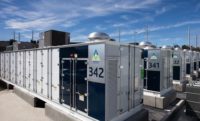Battery Storage is Changing the Dynamics of Renewable Revolution

Workers installing a battery storage unit for Arizona Public Service’s Punkin Center.
PHOTO COURTESY OF FLUENCE

Declining costs of solar power and a continued push for clean energy are driving rapid and large-scale investments in renewable energy resources. But it’s battery storage that’s quickly changing the dynamics of the renewables revolution.
When we talk to utilities of all sizes, even those without significant solar penetration, they see the potential that storage has to fundamentally change the way they do business. They are seeking a path forward – either to help meet customer demand with a lower carbon and emissions footprint, to satisfy rising regulatory mandates for reduced reliance on legacy power generation sources, or to contribute to reliability and resiliency efforts. Announcements like those made recently by an Arizona electric utility —‑together with targets established last year in Massachusetts, New Jersey and most recently New York — demonstrate widespread, growing interest in energy storage as a paradigm-shifting technology. [1]
The initiative in Arizona offers an interesting twist: a focus on providing customers solar-generated electricity after sunset, positioning renewable energy – in this case, the state’s abundant sunshine – to supply power when afternoon solar production declines and energy demand increases.
With 450 MW of battery storage targeted to come online by 2021, and an additional 400 MW by 2025, the investment in Arizona ranks as one of the largest U.S.-based investments in battery storage by an individual utility. This announcement adds to approved plans in 2018 by a California utility for a set of four storage projects that would total more than 567 MW of four-hour duration batteries. [2]
As part of the initial 450 MW target in Arizona, plans call for the retrofit of existing utility-owned solar projects with 200 MW of three-hour duration batteries. Such co-location solar-plus-storage increases opportunities for storage when you consider that, today, projects benefit from the fact that if a battery charges mainly from solar, it can receive the same 30 percent Investment Tax Credit as the solar facility itself. The ability to deliver a power purchase agreement for clean power on-demand is another major attraction for utilities.
Co-location can also help reduce balance of system costs for AC- and DC-coupled systems, particularly with regard to interconnection and land acquisition costs. Black & Veatch is currently performing an engineering study for a major energy client in the South considering stand-alone energy storage and solar photovoltaics with energy storage. Black & Veatch also is performing engineering, procurement, and construction (EPC) on a solar plus storage project in the West. These projects are now being designed to provide grid services, defer grid investment in transmission and distribution, and improve the ability to integrate more clean energy on the grid.
In many ways, battery storage occupies the space held by solar a decade ago. Innovation and excitement were soon tempered by standardization questions and broader doubts about how far the technology could truly take us. With storage, developers and utilities are exploring widespread adoption, while also carefully considering appropriate sizing, balance of system design, control, and protection of storage systems. The investment in Arizona significantly raises the prospects for solar-plus-storage going forward.
These announcements are examples that further validate the important role of storage as part of a diverse energy mix. Heightened competition from new market players and increasing regulatory drivers will contribute to increased project pipelines and allow equipment supply and manufacturing to continue to scale. These dynamics will help bring prices down further, even as tax incentives make it easier for developers and utilities to realize real revenue from these investments.
More than half of respondents in our most recent Black & Veatch Strategic Directions: Electric Report see renewable energy resources, boosted by robust battery deployments, becoming the primary source of generation of electricity in the United States in the next 10 years. Reluctance appears to be giving way to deployments, and as proactive and innovative solutions are brought to the market, more and more utilities are placing solar and storage on their near-term and long-term roadmaps.
Liz Waldren is an Electrical Engineer in Black & Veatch’s Renewable Energy business and leads multiple projects and initiatives related to the deployment and grid integration of renewable energy and energy storage resources. In recent years, she has supported electric utility and developer clients in the design and implementation of renewable and energy storage systems and performed grid integration and interconnection studies for utility-scale renewables and energy storage.



